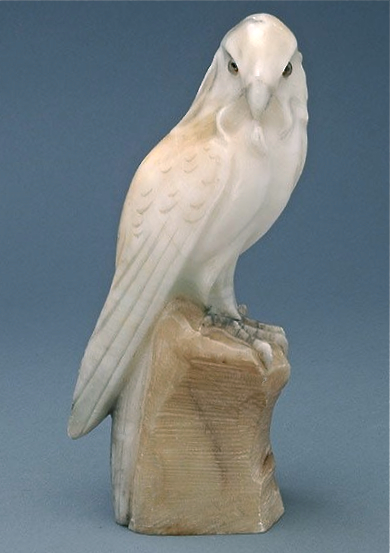

Title: Antique Hand Carved Italian Stone Alabaster Bird Hawk
Shipping: $45.00
Artist: N/A
Period: 19th Century
History: N/A
Origin: N/A
Condition: Museum Quality
Item Date: 1870 to 1910
Item ID: 5761
A Italian, Belle Epoche figure of a hawk, circa 1910. Italian Alabaster Carving of a Hawk, with inset glass eyes {Height 10 inches} This makes a lovely gift for the hawk lover! The hawk is done in Italian stone alabaster and measures 19H. Click on image for greater detail. In Europe, the centre of the alabaster trade today is Florence, Italy. Tuscan alabaster occurs in nodular masses embedded in limestone, interstratified with marls of Miocene and Pliocene age. The mineral is worked largely by means of underground galleries, in the district of Volterra. Several varieties are recognized—veined, spotted, clouded, agatiform, and others. The finest kind, obtained principally from Castellina, is sent to Florence for figure-sculpture, while the common kinds are carved locally, into vases, lights, and various ornamental objects. These items are objects of extensive trade, especially in Florence, Pisa, and Livorno. Spain and many other countries have deposits which have been worked. We are committed to enhancing our customer’s lives by discovering creating, and pointing out only the best art we can find in the world today. We Are Taste-Makers, Art Advisers, Consultants & Publishers of Great Stories.
Link: http://en.wikipedia.org/wiki/Belle_Époque
The Belle Époque or La Belle Époque (French pronunciation: [bɛlepɔk]; French for "Beautiful Era") was a period in French history that is conventionally dated as starting in 1871 and ending when World War I began in 1914. Occurring during the era of the Third French Republic (beginning 1870), it was a period characterized by optimism, peace at home and in Europe, new technology and scientific discoveries. The peace and prosperity in Paris allowed the arts to flourish, and many masterpieces of literature, music, theater, and visual art gained recognition. The Belle Époque was named, in retrospect, when it began to be considered a "golden age" in contrast to the horrors of World War I.
Belle Époque period was based largely on the peace and prosperity connected with it in retrospect. Two devastating world wars and their aftermath made the Belle Époque appear to be a time of joie de vivre (joy of living) in contrast to 20th century hardships. In contrast to the early 20th century, the Belle Époque was a time of relative peace and prosperity.
during the Belle Époque. Among the post-Impressionist movements in Paris were the Nabis, the Salon de la Rose + Croix, the Symbolist movement (in music as well as visual art), Fauvism, and early Modernism. Between 1900 and 1914, Expressionism took hold of many artists in Paris and Vienna. Early works of Cubism and Abstraction were exhibited. Foreign influences were being strongly felt in Paris as well. The official art school in Paris, the Ecole des Beaux Arts, held an exhibition of Japanese printmaking that changed approaches to graphic design, particular posters and book illustration (Aubrey Beardsley was influenced by a similar exhibit when he visited Paris during the 1890s). Exhibits of African tribal art also captured the imagination of Parisian artists at the turn of the 20th century.
Art Nouveau is the most popularly recognized art movement to emerge from the period. This largely decorative style (Jugendstil in central Europe), characterized by its curvilinear forms, become prominent from the mid-1890s and dominated progressive design throughout much of Europe. Its use in public art in Paris, such as the Paris Metro stations, has made it synonymous with the city.